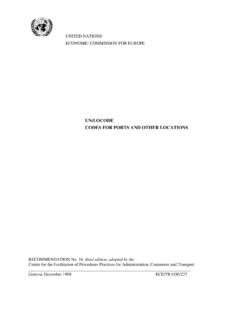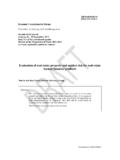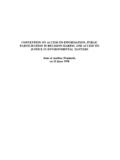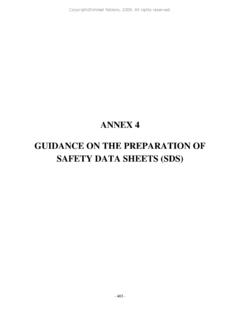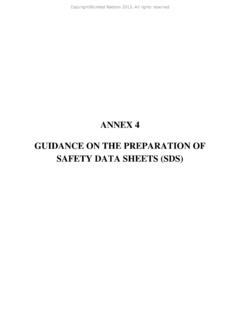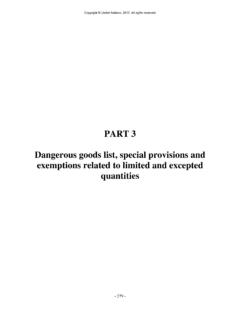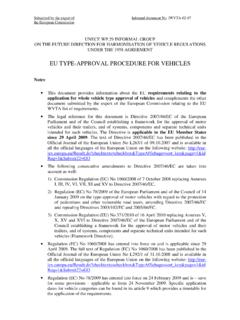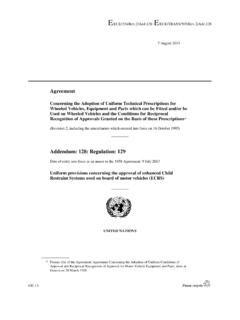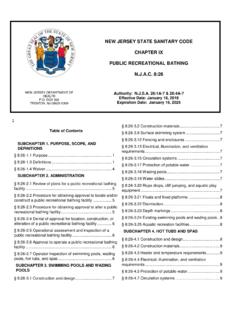Transcription of The Globally Harmonized System of Classification and ...
1 The Globally Harmonized System of Classification and Labelling of Chemicals (GHS)Hazard communicationCopyright@United Nations, 2017. All rights reservedObjectiveDevelop a Harmonized hazard communication System , including:-Labelling;- Safety Data Sheets (SDS s)based on GHS Classification criteriaCopyright@United Nations, 2017. All rights reservedTarget audiences: needs Factors considered:- Potential use of products- Availability of information other than label- Availability of specific training Needs:- Workplace: labels, SDS, specific training- Consumers: labels - Emergency responders: labels, specific training- Transport: labels, transport documents, specific trainingCopyright@United Nations, 2017. All rights reservedComprehensibility of hazard communication elementsGuiding principles: Information should be conveyed in more than one way Comprehensibility should take account of existing information (literature, studies and data) Phrases indicating degree of hazard should be consistent across different hazard types Words and phrases should retain comprehensibility when translated into other languages Format and colour of the label elements, and SDS format should be standardizedCopyright@United Nations, 2017.
2 All rights reservedUpdating informationLabels and Safety Data Sheets should beupdated when new and significant information is available for a chemical New and significant information meansany information that changes GHS Classification and leads to a change in the information to be provided in the label or in the SDSC opyright@United Nations, 2017. All rights reservedLabelling according to GHSI nformation required on a GHS label: Pictograms Signal words Hazard statements Precautionary statements and pictograms Product identifier Supplier informationCopyright@United Nations, 2017. All rights reservedPictograms (1) Definition:Graphical composition that includes a symbol and other graphic elements, such as a border, background pattern or colour that is intended to convey specific information Characteristics:-Shape: square set at a : Symbol: black; Background: white; Border: red*.
3 (* In same cases, competent authorities may allow the use of a black border)Pictograms and a code uniquely identifying each one GHSxx are listed in section 4 of Annex 3 of the GHS. The pictogram code is intended to be used for references purposes. It is not part of the pictogram and should not appear on labels or in section 2 of the safety data : GHS pictogram for skin irritant Copyright@United Nations, 2017. All rights reservedPictograms (2) Packages covered by the UN model Regulations:-For transport, the pictograms (labels) prescribed by the UN model Regulations should be used -For specifications for transport pictograms see Part 5 of the UN model Regulations-If a transport pictogram appears on the package, the GHS pictogram for the same hazard should not appear 3 Example: Transport pictogram for flammable liquidsCopyright@United Nations, 2017. All rights reservedSignal words Definitionword used to indicate the relative level of severity of hazard and alert the reader to a potential hazard on the label Danger (for more severe hazard categories) Warning (for less severe hazard categories)Copyright@United Nations, 2017.
4 All rights reservedHazard statementsDefinition:phrase assigned to a hazard class and category that describes the nature of the hazards of a hazardous product, including, where appropriate, the degree of statements and a code uniquely identifying each one Hxxx are listed in section 1 of Annex 3 of the GHS. Hazard statement codes are intended to be used for reference purposes only, are not part of the hazard statement text and should not be used to replace it Examples of hazard statements are:- Highly flammable liquid and vapour (H225)- Toxic in contact with skin (H311)- Harmful to aquatic life (H402)Copyright@United Nations, 2017. All rights reservedPrecautionary statementsDefinition:phrases (and/or pictograms) that describe recommended measures that should be taken to minimise or prevent adverse effects resulting from exposure to a hazardous product, or improper storage or handling of a hazardous statements and a code uniquely identifying each one Pxxx are listed in section 2 of Annex 3 of the GHS.
5 Precautionary statement codes are intended to be used for reference purposes only, are not part of the precautionary statement text and should not be used to replace itCopyright@United Nations, 2017. All rights reservedPrecautionary statements5 types of precautionary statements: General (codes P1xx ) Prevention (codes P2xx ); Response (in case of spillage or exposure) (codes P3xx); Storage (codes P4xx ); and Disposal (codes P5xx );Annex 3 of the GHS provides guidance on the use of precautionary statements consistent with GHSC opyright@United Nations, 2017. All rights reservedPrecautionary pictogramsTo be used where allowed by the competent :(Additional examples may be found in section 5 of Annex 3 of the GHS)Copyright@United Nations, 2017. All rights reservedProduct identifier Chemical identity of the substance For mixtures and alloys, chemical identities of:-all the ingredients/alloying elements contributing to the hazard of the mixture/alloy (as specified by the competent authority); or, -all the ingredients/alloying elements contributing to:o Acute toxicity o Skin corrosion/serious eye damageo Germ cell mutagenicityo Carcinogenicityo Reproductive toxicityo Skin/respiratory sensitizationo Specific target organ toxicitywhen these hazards appear on the labelCopyright@United Nations, 2017.
6 All rights reservedProduct identifier and supplier identificationProduct identifier (cont d): Proper shipping name (for substances/mixtures covered by the UN model Regulations) For substances/mixtures supplied exclusively for workplace use:-Competent authority may authorize chemical identities to be included only in a substance/ingredient meets the competent authority criteria for CBI, its identity does not have to be included on the labelSupplier identification Name, address and telephone number of the manufacturer or supplier of the substance/mixtureCopyright@United Nations, 2017. All rights reservedExample of arrangement of label elementsFor additional examples of arrangements of the GHS labels see Annex 7 of the GHSC opyright@United Nations, 2017. All rights reservedPrecedence of hazard informationSymbols and signal wordsSymbols: For physical hazards: Substances/mixtures covered by UN model Regulations: as specified by the model Regulations Workplace: as specified by competent authority For health hazards:-Exclamation mark should not appear if:-if skull and crossbones applies; or-if used for skin sensitization or skin/eye irritation:-if corrosive symbol applies-if the health hazard symbol appears for respiratory sensitizationSignal words: If Danger applies, warning should not appearCopyright@United Nations, 2017.
7 All rights reservedPrecedence of hazard informationHazard statements All assigned hazard statements should appear on the label, except where otherwise provided below. The competent authority may specify the order in which they appear The following precedence rules may be applied: If statement H410 Very toxic to aquatic life with long lasting effects is assigned, statement H400 Very toxic to aquatic life may be omitted If statement H411 Toxic to aquatic life with long lasting effects is assigned, statement H401 Toxic to aquatic life may be omitted If statement H412 Harmful to aquatic life with long lasting effects is assigned, statement H402 Harmful to aquatic life may be omitted If statement H314 Causes severe skin burns and eye damage is assigned, statement H318 Causes serious eye damage may be omitted Competent authorities may decide whether to require use of the above precedence rules, or to leave the choice to the manufacturer/supplier Where a combined hazard statement is indicated, the competent authority may specify whether the combined hazard statement or the corresponding individual statements should appear on the label.
8 Or may leave the choice to the manufacturer/supplierCopyright@United Nations, 2017. All rights reservedLabelling of small packagingsGeneral principles(a)All applicable GHS label elements should appear on the immediate container of a hazardous substance or mixture where possible(b)Where it is impossible to put all the applicable label elements on the immediate container itself, other methods of providing the full hazard information should be used in accordance with the definition of Label in the GHS. Factors influencing this include inter alia:(i)the shape, form or size of the immediate container(ii)the number of label elements to be included, particularly where the substance or mixture meets the Classification criteria for multiple hazard classes(iii)the need for label elements to appear in more than one official language(c)Where the volume of a hazardous substance or mixture is so low and the supplier has data demonstrating, and the competent authority has determined, that there is no likelihood of harm to human health and/or the environment, then the label elements may be omitted from the immediate container(d)Competent authorities may allow certain label elements to be omitted from the immediate container for certain hazard classes/categories where the volume of the substance or mixture is below a certain amount(e)
9 Some labelling elements on the immediate container may need to be accessible throughout the life of the product, for continuous use by workers or consumersCopyright@United Nations, 2017. All rights reservedSafety Data Sheets Provide comprehensive information of a substance/mixture for use in workplace Are product related The information provided enables the employer:- To develop worker protection measures specific to the workplace- To consider measures to protect the environmentCopyright@United Nations, 2017. All rights reservedSafety Data Sheets SDS should be provided for:- all substances/mixtures meeting GHS Harmonized criteria for physical, health and environmental hazards- mixtures containing substances meeting criteria for carcinogenicity, toxicity for reproduction or specific target organ toxicity, in concentration exceeding cut-off values- other substances/mixtures not meeting the criteria for Classification as hazardous but containing hazardous substances in certain concentrations, if required by the competent authorityCopyright@United Nations, 2017.
10 All rights reservedSafety Data SheetsInformation should be presented as follows1. Identification 2. Hazard(s) identification3. Composition/information on ingredients4. First-aid measures5. Fire-fighting measures6. Accidental release measures7. Handling and storage8. Exposure controls/personal protection9. Physical and chemical properties10. Stability and reactivity11. Toxicological information12. Ecological information13. Disposal considerations14. Transport information15. Regulatory information16. Other detailed guidance on the preparation of SDS refer to Annex 4 of the GHSC opyright@United Nations, 2017. All rights reservedSafety Data Sheets: Sections 1 and 2 Section 1: Identification Identification of the substance or mixture: GHS identifier Other unique identifiers Supplier s details: Name, full address and phone number(s) Recommended use of the chemical and restrictions on use; and Emergency phone numberSection 2: Hazard identification Classificationofthesubstanceormixture GHSlabels,includingprecautionarystatemen ts Otherhazardswhichdonotresultinclassifica tionCopyright@United Nations, 2017.
